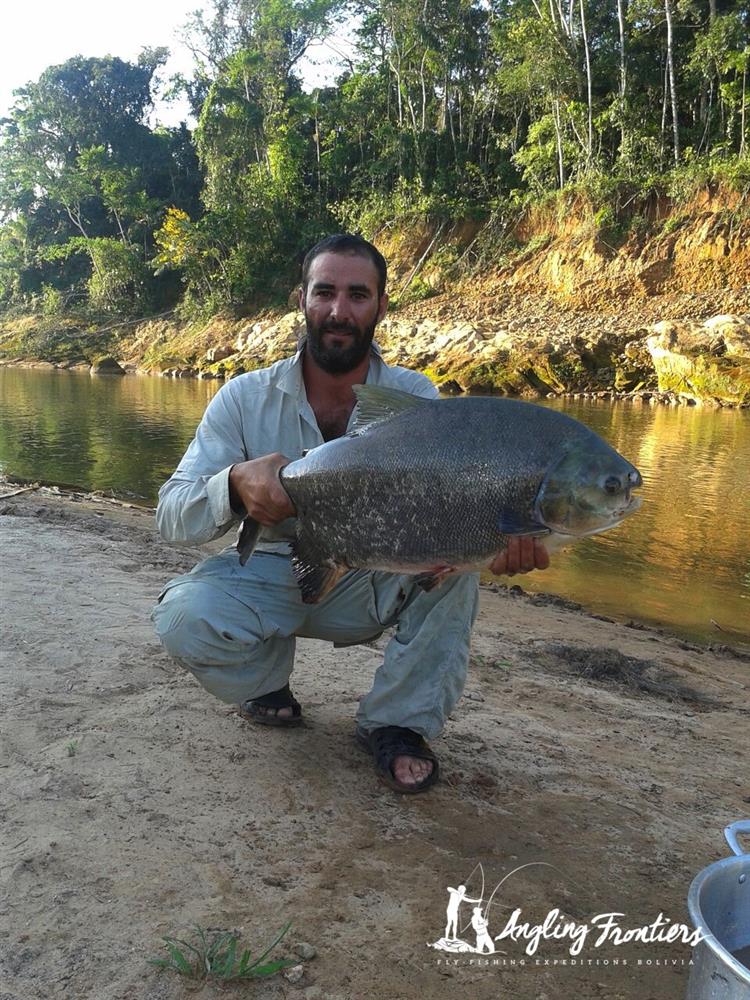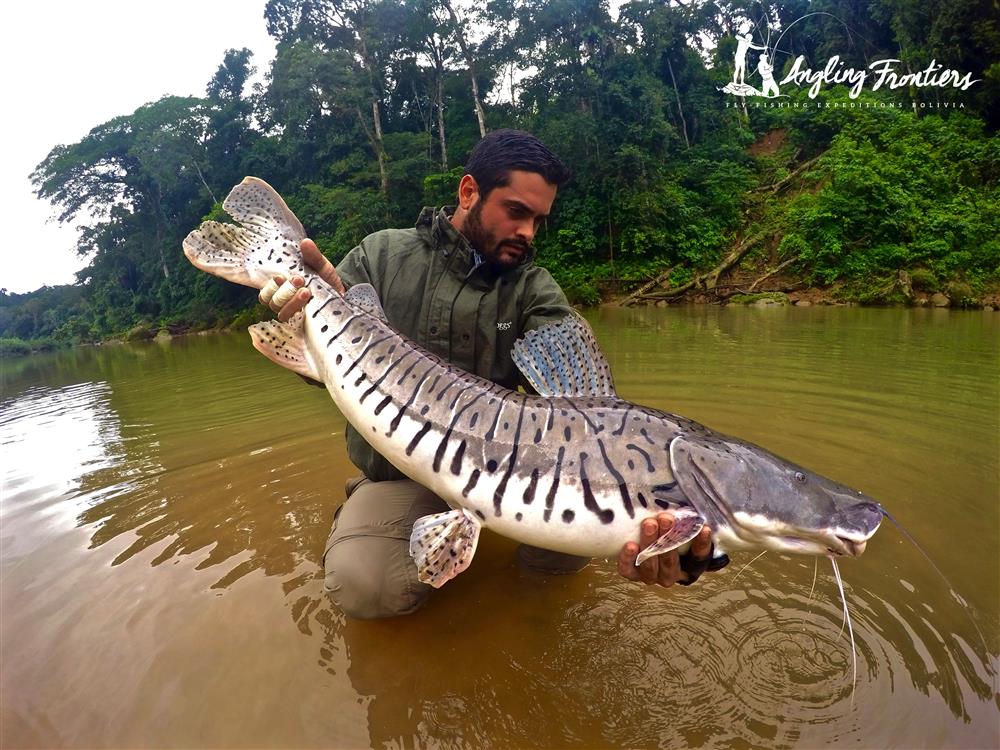The Species
Our Signature Fish. Salminus maxillosus or the Golden Dorado, from the Characidae family, are the number one predator in our waters. The Golden Dorado possess a bright golden coloration, accented by rows of tiny small back dots running along their powerful streamlined bodies. Their massive heads and matching jaws are equipped with rows of razor sharp pointy teeth. Golden Dorado can reach upwards of 100cm in length and weigh as much as 45lbs (20.5kgs), making it the worst nightmare of pretty much every single sabalo and small to medium fish or animal that happens to be in the water at the wrong place and time. This fish is a force to be reckoned with, and is the single most important species in this river system. They attack flies with tremendous power and ferocity and break water thrashing violently several times in efforts to break off. The aggression in its fight and awe-inspiring beauty is the reason for the project and its success in protecting this area. The Golden Dorado are considered guardians of the river according to the indigenous Tsimane folklore, and for the first time in this river, sport fishing eco-tourism has allowed them to really show their worth.
Our Fish Species. Below you will find a list of the commonly encountered fish species during our Fly Fishing Expedition.
Dorado or Golden Dorado

Kingdom: Animalia
Phylum: Chordata
Class: Actinopterygii
Order: Characiformes
Family: Characidae
Genus: Salminus
Species: Maxillosus
Binomial Name: Salminus maxillosus
Others: Salminus cuvieri
Characteristics:
- Referred to as the “Tigre de Rio” or jaguar of the river
- Possess a bright golden coloration, accented by rows of tiny small back dots running along their powerful streamlined bodies
- Fins have a bright red coloration and the caudal fin has a black bar along the middle through the caudal peduncle
- Massive jaws are equipped with rows of razor sharp pointy teeth
- Can reach upwards of 100cm in length and weigh as much as 45lbs (20.5kgs)
Tabarana: the Silver Dorado

Kingdom: Animalia
Phylum: Chordata
Class: Actinopterygii
Order: Characiformes
Family: Characidae
Genus: Salminus
Species: hilarii
Binomial Name: Salminus hilarii
Phylum: Chordata
Class: Actinopterygii
Order: Characiformes
Family: Characidae
Genus: Salminus
Species: hilarii
Binomial Name: Salminus hilarii
Characteristics:
- Close relative of the Dorado (smaller in average size and less girth) and shares many of its morphological features
- Silver with bright orange specks between scales, and black and red accents on the caudal fin, as well as black accents on the dorsal and anal fins
- Referred to as the “white or silver dorado” in much of its range
- Quite aggressive and preys upon smaller tetras and other baitfish
- Sharp teeth make quick work of the smaller characins in the river system
- Reach sizes of 3kgs but average size are less than 2kgs
- Great sporting fish– putting up a fierce fight
Yatorana

Kingdom: Animalia
Phylum: Chordata
Class: Actinopterygii
Order: Characiformes
Family: Bryconidae
Genus: Brycon
Species: moorei
Binomial Name: Brycon moorei
Others: B. cephalus, B. sp.
Phylum: Chordata
Class: Actinopterygii
Order: Characiformes
Family: Bryconidae
Genus: Brycon
Species: moorei
Binomial Name: Brycon moorei
Others: B. cephalus, B. sp.
Characteristics:
- Schooling fish, but can be found individually along the river shores
- Similar to the Dorado in feeding and habitat requirements
- Is a piscivore- feeding on small invertebrates and baitfish
- Silvery fish, with an olivaceous tinge dorsally and a shade of black on the ventral posterior end of the body
- Built for speed and fast water: will be found in fast flows among structure, runs and heads and tails of deep pools
- Hunt around structure on the shoreline and next to rock drop offs
- Can reach lengths of up to 50cm and up to 5kg (11lbs)
Pacu or Pirapitinga

Kingdom: Animalia
Phylum: Chordata
Class: Actinopterygii
Order: Characiformes
Family: Characidae
Genus: Piaractus
Species: brachypomus
Binomial Name: Piaractus brachypomus
Others: P. mesopotamicus, Colossoma macropomum
Phylum: Chordata
Class: Actinopterygii
Order: Characiformes
Family: Characidae
Genus: Piaractus
Species: brachypomus
Binomial Name: Piaractus brachypomus
Others: P. mesopotamicus, Colossoma macropomum
Characteristics:
- Can range from a silvery gray to yellowish ventrally, and a dark gray to dark silvery dorsal region
- brachypomum will have the distinctive red in the belly
- Large and oval shaped, they are able to negotiate strong currents
- Omnivore: it possesses strong robust teeth and jaws used to crack nuts from falling fruit
- Present around overhanging fruiting trees and deep pools and eddies
- Will go slightly carnivorous during the dry season chasing baitfish, insects, and taking advantage of any carrion
- Measure up to 50cm and weigh anywhere between 6-25lbs
Surubi or Striped Catfish

Kingdom: Animalia
Phylum: Chordata
Class: Actinopterygii
Order: Siluriformes
Family: Pimelodidae
Genus: Pseudoplatystoma
Species: fasciatum
Sub-species: Sorubiminae
Binomial Name: Pseudoplatystoma fasciatum
Others: Pseudoplatystoma tigrinum, P. corruscans, P. magdaleniatum , P. punctifer
Phylum: Chordata
Class: Actinopterygii
Order: Siluriformes
Family: Pimelodidae
Genus: Pseudoplatystoma
Species: fasciatum
Sub-species: Sorubiminae
Binomial Name: Pseudoplatystoma fasciatum
Others: Pseudoplatystoma tigrinum, P. corruscans, P. magdaleniatum , P. punctifer
Characteristics:
- Have black markings as either vertical lines, a maze of lines, or spots on the dorsal side of the body (typically a bluish gray, or darker gray coloration)
- Ventral side of the body is white, showing some accents of pinkish red on the extreme of the lower body fins
- Their rostrum is elongated in a shovel like shape, with eyes located on the upper side
- Very “shark-looking” and actually are voracious roving predators
- Can reach up to 40kgs (88lbs) and 1.5 meters in length, ( commonly in the 10-30kg range)
Muturo (a.k.a Jau)

Kingdom: Animalia
Phylum: Chordata
Class: Actinopterygii
Order: Siluriformes
Family: Pimelodidae
Genus: Zungaro
Species: zungaro
Binomial Name: Zungaro zungaro
Phylum: Chordata
Class: Actinopterygii
Order: Siluriformes
Family: Pimelodidae
Genus: Zungaro
Species: zungaro
Binomial Name: Zungaro zungaro
Characteristics:
- Caught in two color phases: petroleum green (muturo) and bright yellow coloration, when they are referred to as “amarillo”
- Display very faint dark spots along the body, and others are solid color
- Have huge gaping mouths and large plates of tiny sharp teeth used to secure prey
- Heavier than longer, these fish are stocky, and can achieve huge sizes.
- Carnivorous: attacks prey such as smaller Catfishes, Sabalo baitfish, or Boga
- Found in rivers and dwell in the deep holes formed by large eddies or deep holes around rocks and boulders
- Found in stained and clear water rivers
- Can weigh up to 100kg and a reach lengths of up to 2 meters
Sabalo

Kingdom: Animalia
Phylum: Chordata
Class: Actinopterygii
Order: Characiformes
Family: Prochilodontidae
Genus: Prochilodus
Species: lineatus
Binomial Name: Prochilodus lineatus
Phylum: Chordata
Class: Actinopterygii
Order: Characiformes
Family: Prochilodontidae
Genus: Prochilodus
Species: lineatus
Binomial Name: Prochilodus lineatus
Characteristics:
- Silvery schooling fish, and main characteristic is their protractile mouth with huge lips that form an oral disc when projected
- Tiny rasping teeth, they scrape off detritus and algae from structure and also pick it up from floating or suspended substrate
- Takes part in huge migrations for spawing in the headwaters of rivers
- Forms the basic prey item: every predatory fish in the river will eat this species at differing stages of its growth
- Can be anywhere from less than a pound to 7kgs.
